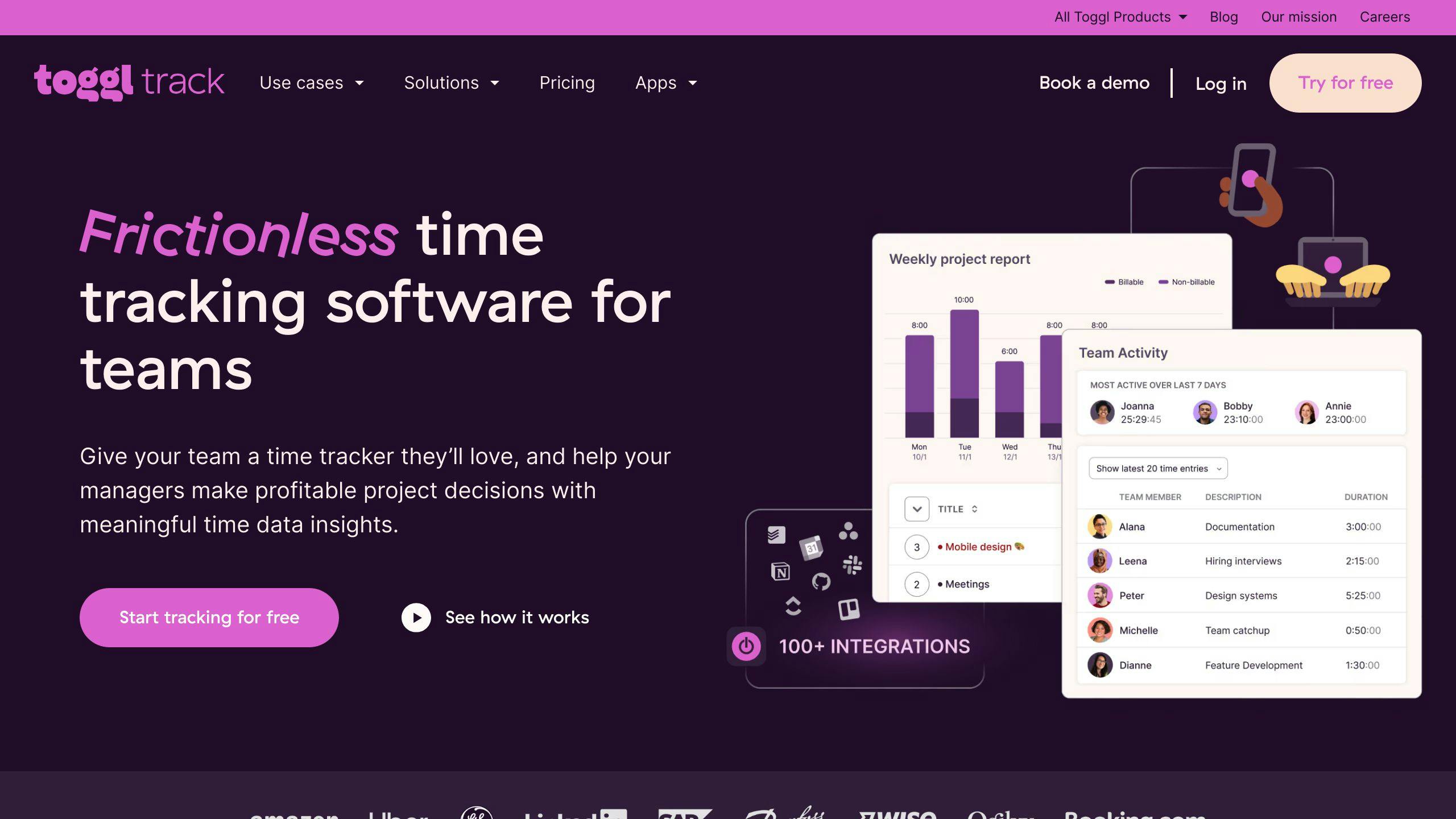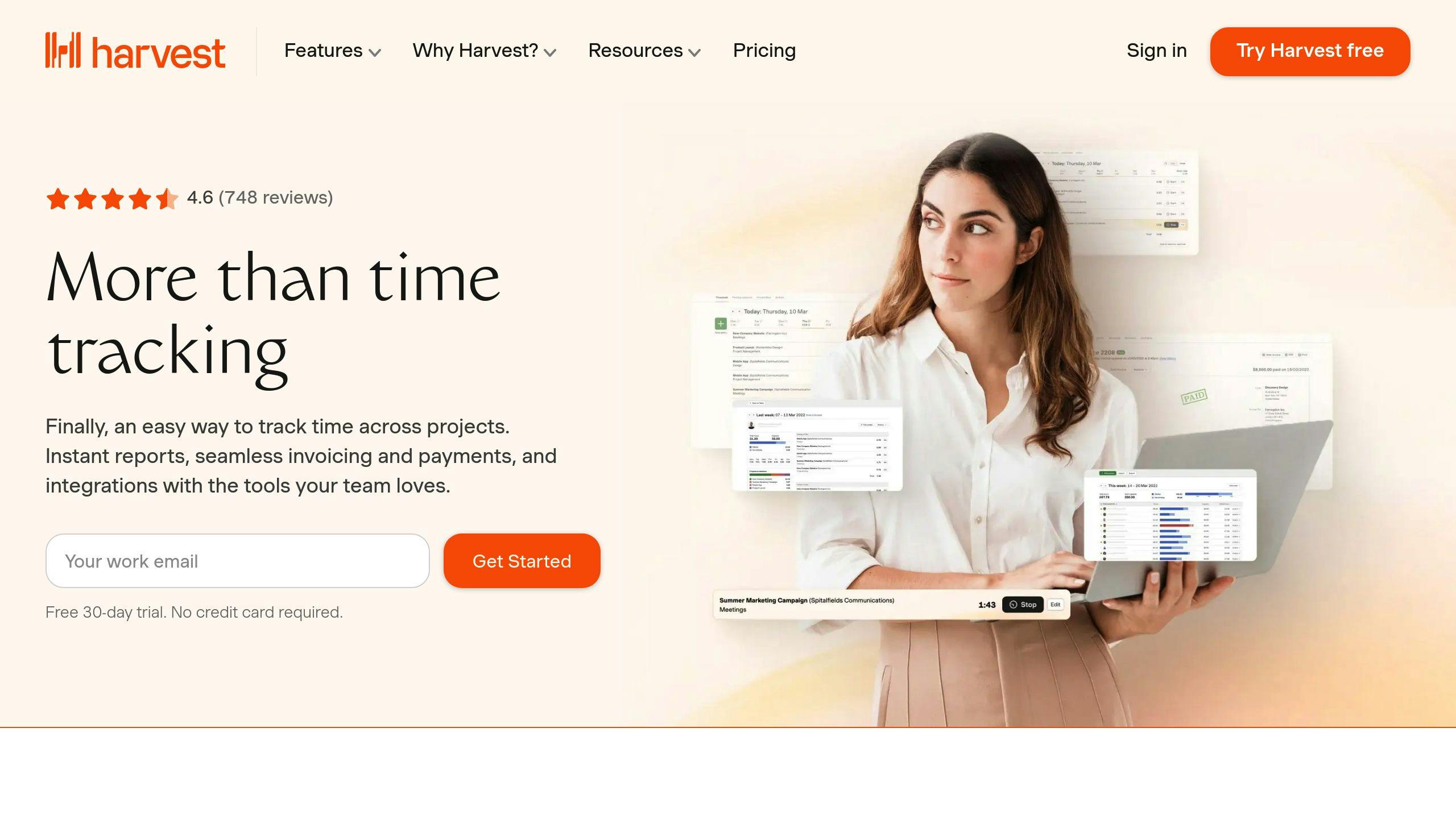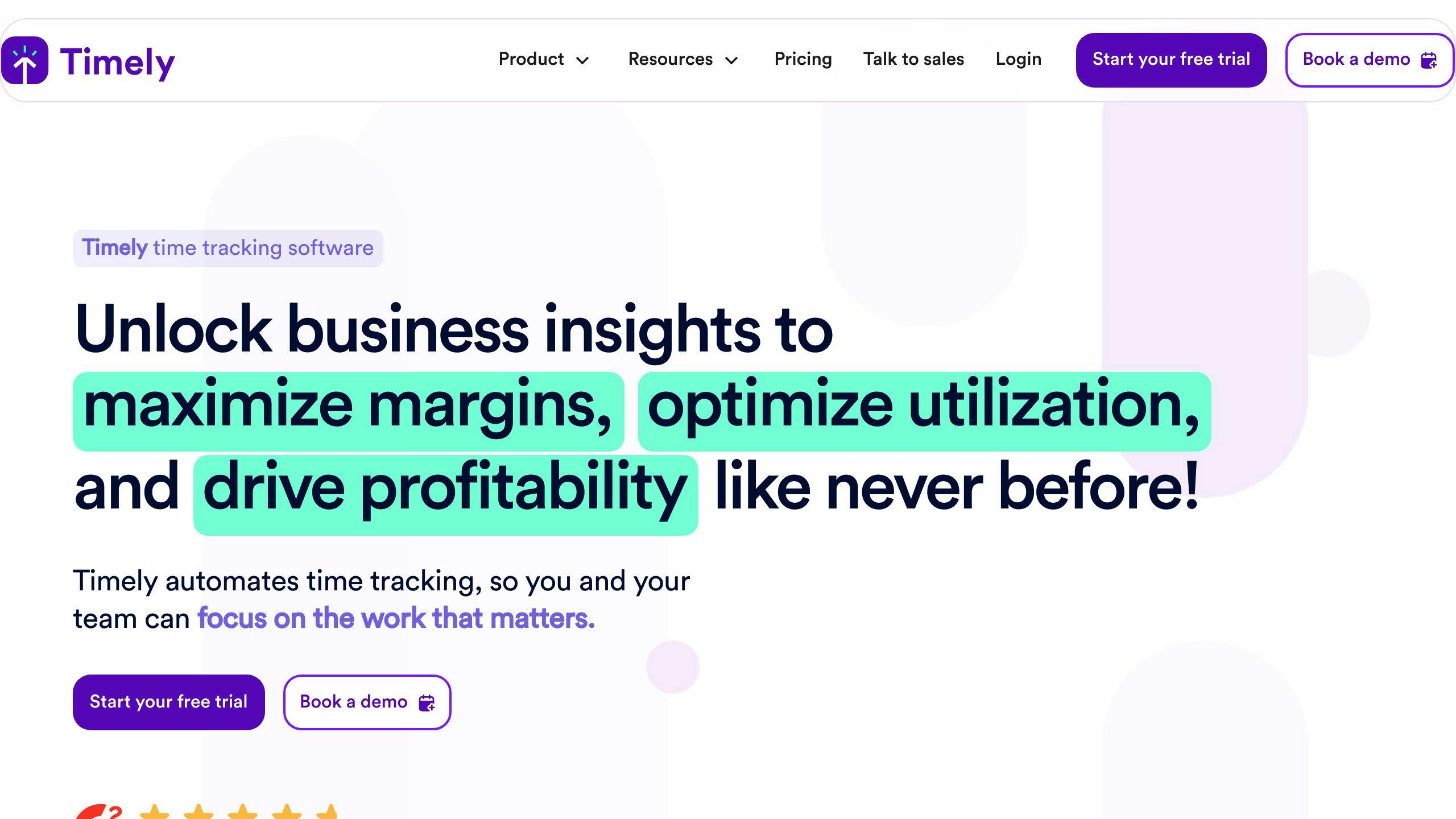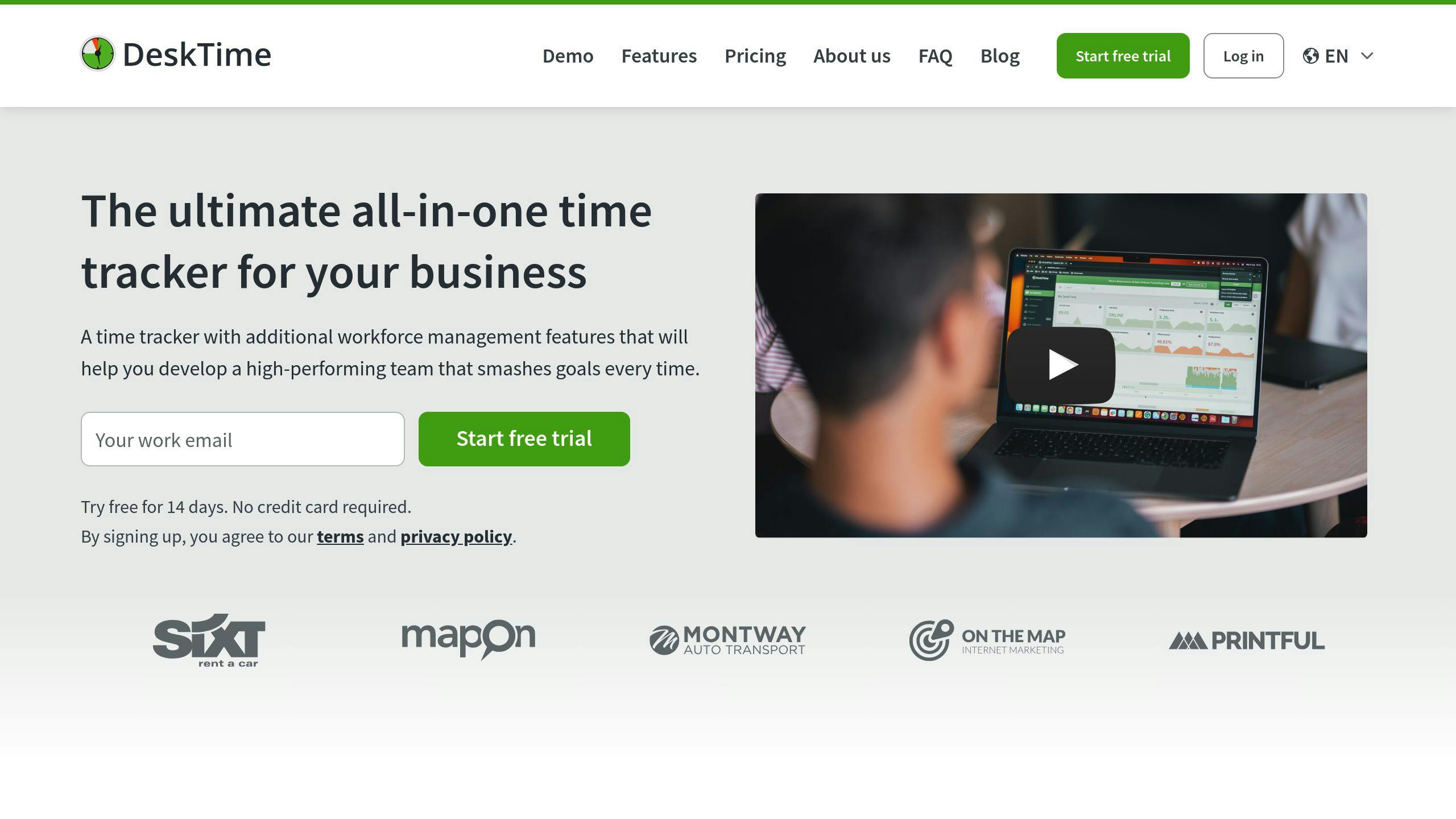Boost your productivity and manage projects better with these top free time tracking apps:
- Clockify: Unlimited users and projects
- Toggl Track: 100+ integrations
- ClickUp: All-in-one project management
- TimeCamp: Automatic time tracking
- Jibble: GPS and facial recognition
- Harvest: Time tracking + invoicing
- Hubstaff: GPS tracking and screenshots
- Timely: AI-powered auto-tracking
- DeskTime: Productivity analysis
- My Hours: Project management focus
Quick Comparison
| App | Best For | Standout Feature | Free Plan Limit |
|---|---|---|---|
| Clockify | Teams of any size | Unlimited everything | No limit |
| Toggl Track | Freelancers, small teams | 100+ integrations | 5 users |
| ClickUp | Teams wanting all-in-one | Project management | Limited storage |
| TimeCamp | Remote teams | Auto-tracking | 1 user |
| Jibble | Startups | Mobile-friendly | Unlimited users |
| Harvest | Freelancers, agencies | Built-in invoicing | 1 user, 2 projects |
| Hubstaff | Field workers | GPS tracking | 1 user |
| Timely | Hands-off trackers | AI auto-tracking | No free plan |
| DeskTime | Office-based teams | Productivity analysis | 1 user |
| My Hours | Project-based work | Detailed reporting | 5 users |
Choose based on your team size, integration needs, and specific features like invoicing or auto-tracking. Test a few to find the best fit for your workflow.
How We Picked These Apps
We focused on what developers actually need in time tracking apps. Here’s what mattered:
- Project Integration: Works with Jira, Trello, GitHub, etc.
- Ease of Use: Simple interface. No learning curve.
- Reporting: Detailed analytics for billing and productivity.
- Customization: Adapts to your workflow.
- Free Plan: Solid free options, not just trials.
Our criteria breakdown:
| Criteria | Weight |
|---|---|
| Core Functionality | 25% |
| Standout Features | 25% |
| Usability | 10% |
| Onboarding | 10% |
| Customer Support | 10% |
| Value For Money | 10% |
| User Reviews | 10% |
We tested each app ourselves, for both solo devs and teams. The goal? Find tools that help, not hinder.
“The best time tracking app is the one you’ll actually use”, says Sarah Chen, CTO of DevTrack. “It should feel like a natural part of your workflow, not an interruption.”
We looked at pricing too. While we focused on free options, we checked upgrade paths. Most apps offer paid plans from $5 to $20 per user/month, with enterprise options.
1. Clockify

Clockify is a free time tracking app that developers love. It’s web-based and packed with features for solo devs and teams alike.
What makes Clockify stand out?
- Free plan with no limits on users or projects
- Track time in your browser, desktop, or with an extension
- Get detailed reports and stats
- Works with popular project management tools
The best part? It’s super easy to use. You can start tracking time right away without any headaches.
“Stay lean. Move fast. See everything.” - Nenad Milanovic, Clockify Co-founder
This sums up Clockify’s approach perfectly.
Working on multiple projects? No problem. Clockify lets you track time across different projects, tasks, and clients. Then, you can analyze where your time’s going.
Need help staying focused? Try the Pomodoro timer. It’s great for boosting productivity and avoiding burnout.
While the free plan is awesome, Clockify also offers paid options:
| Plan | Price (per user/month) | What You Get |
|---|---|---|
| Free | $0 | Unlimited everything + basic reports |
| Basic | $3.99 | Time audits, custom exports |
| Standard | $5.49 | Approve timesheets, invoice |
| Pro | $7.99 | GPS tracking, screenshots |
| Enterprise | $11.99 | SSO, advanced user management |
Clockify plays nice with over 80 web apps, including Jira, GitHub, and Trello. So you can track time without messing up your workflow.
Just keep in mind: some users find the reports a bit basic, and the interface isn’t the most modern.
But if you want a free time tracker with solid features, Clockify is tough to beat. It’s especially great for small teams or startups on a budget.
2. Toggl Track

Toggl Track is a top free time tracking app for developers. It works on web, desktop, mobile, and as browser extensions.
Key features:
- One-click timer
- Offline mode
- Project management
- Detailed reports
- 100+ integrations (GitHub, Jira)
The free plan supports 5 users with unlimited time entries. Perfect for small teams or freelancers.
Pricing:
| Plan | Price (per user/month) | Key Features |
|---|---|---|
| Free | $0 | Basic tracking, unlimited projects |
| Starter | $10 | Billable rates, time estimates |
| Premium | $20 | Team management, forecasts |
| Enterprise | Custom | Priority support, training |
Andy, a software consultant, says: “Chose Toggl Track after trialing 20+ similar tools.”
Real impact:
- Perception Engineering: 40+ hours saved monthly
- Newlogic: 100% team adoption
- Sweat+Co PR: 20% increased profitability
Toggl Track focuses on trust, not surveillance.
Pros and cons:
- Cross-platform support
- Generous free plan
- Detailed categorization
- Offline sync needs internet
- Manual tracking can be forgotten
- Some find notifications excessive
With 145 integrations and API access, Toggl Track plays well with other tools. Its customizable dashboards and Insights tool help analyze productivity and profitability.
For developers, Toggl Track offers a solid mix of features, ease of use, and scalability.
3. ClickUp

ClickUp is a Swiss Army knife for developers. It’s not just time tracking - it’s project management, goal setting, and team chat all rolled into one.
Here’s what ClickUp brings to the table:
- Track time on desktop, mobile, or Chrome
- View tasks as lists, boards, calendars, or Gantt charts
- Play nice with 1000+ other apps
- Bend workflows to your will
- Work offline and sync later
ClickUp’s time tracking isn’t just about clocking hours. It’s about understanding where your time goes. And with the Chrome extension, you can track time while you browse.
Pricing? Here’s the breakdown:
| Plan | Price (per user/month) | What you get |
|---|---|---|
| Free Forever | $0 | Basics, limited storage |
| Unlimited | $5 | Unlimited storage, built-in time tracking |
| Business | $12 | Export how you want, bring in guests |
| Business Plus | $19 | Share with your team, automate more |
| Enterprise | Custom | Talk to sales |
The free plan lets you track time 60 times. Need more? Upgrade.
One user raves:
“ClickUp is a breeze to use. It’s not just easy for the team - it’s a cinch to customize and get the most out of it.” - Oskar B., Verified User in Computer Software
But it’s not all sunshine and rainbows:
- Time reports are basic
- Some find the interface tricky
- Mobile app timers can be glitchy
How does it stack up?
| Feature | ClickUp | Other Time Trackers |
|---|---|---|
| Log time for others | Nope | Often yes |
| Time approval | Nada | Common |
| Project budgeting | So-so | Usually better |
| Custom reports | Basic | Often more advanced |
ClickUp is great if you want one tool to rule them all. But if you’re after deep time analytics, you might need to keep looking.
4. TimeCamp

TimeCamp is a time tracking app that’s perfect for remote dev teams. It runs in the background, so you can focus on coding, not clock-watching.
Here’s what TimeCamp offers:
- Automatic time tracking
- Keyword-based task sorting
- Project and task organization
- Detailed reporting
- Productivity monitoring
TimeCamp’s automatic tracking is like having a personal assistant. It logs time spent on emails, meetings, and document editing without you lifting a finger.
For developers, TimeCamp shines with its integrations. It works with Trello, Asana, Jira, Slack, and more. No more app-hopping to track your time.
Here’s the pricing breakdown:
| Plan | Price (per user/month) | Features |
|---|---|---|
| Free | $0 | Unlimited users, basic features |
| Basic | $7 | Time tracking, productivity tools |
| Pro | $10 | Team management, invoicing |
| Enterprise | Custom | All features, custom integrations |
The free plan is solid, offering unlimited users and basic tracking. Paid plans start at $7 per user per month.
TimeCamp doesn’t just track time - it helps you understand your work habits. You can see which projects are time-sinks and when you’re most productive.
Pro tip: Install the TimeCamp app and browser extensions to catch all your work time across different tools and websites.
One quirk: The automatic timer only works on the timesheet window. If you like seeing a timer tick away, you might need to adjust.
TimeCamp’s reputation is strong, with 4.7 out of 5 on both Capterra and G2. But it’s not perfect - some users find the interface cluttered, and the mobile app can be glitchy.
Bottom line: If you’re a remote developer wanting a time tracker that does the heavy lifting, TimeCamp’s worth checking out. It’s especially useful for juggling multiple projects or clients.
Just remember, TimeCamp can track your time automatically, but it can’t write your code. Yet.
5. Jibble

Jibble is a free time tracking app that’s catching on with developers. It’s cloud-based and helps teams track attendance and billable hours.
Here’s what Jibble offers:
- Free plan with unlimited users
- GPS and facial recognition for clock-ins
- 800+ app integrations
- Custom schedules and break rules
- Detailed timesheets and reports
Jibble’s free plan packs a punch:
| Feature | What It Does |
|---|---|
| Time Tracking | Log time for projects and tasks |
| GPS Tracking | Check work locations for remote teams |
| Biometric Verification | Use facial recognition to clock in |
| Reporting | Get timesheets and productivity data |
| Integrations | Link with project management tools |
Jibble shines for multi-project developers. You can hop between tasks and see where your time goes.
The app plays well with others, too. One developer said:
“We use Zoho Flow to link Zoho Billing with JotForm. Customer preferences from JotForm automatically create subscriptions in Zoho Billing. Setting it up was a breeze with the drag-and-drop interface!” - Josh Lucas, Head of Operations, AAA Band Rentals
Got spotty internet? No problem. Jibble works offline, so you won’t lose data.
While the free plan is solid, Jibble also has paid options:
- Power Plan: $3.99 per user/month
- Ultimate Plan: $7.99 per user/month
These add group management, live location tracking, and client-based time tracking.
Heads up: Solo developers might find Jibble pricey, as paid plans require a minimum of three users.
For teams, Jibble is easy to set up. A quick training session can get everyone on board.
Developers love Jibble’s user-friendly design and helpful support. Its reporting feature is great for sending detailed client reports, making billing a breeze.
6. Harvest

Harvest isn’t just another time tracker. It’s a Swiss Army knife for developers, handling time, projects, and billing in one go.
What’s in the Harvest toolbox?
- Track time on any device
- Manage projects
- Invoice and get paid
- Crunch the numbers
The free plan? It’s basic but useful:
| Feature | Free Plan |
|---|---|
| Users | 1 |
| Projects | 2 |
| Clients | Unlimited |
Juggling multiple projects? The Pro plan ($12/user/month) unlocks everything.
Developers love Harvest’s simplicity:
“Analytics, UI, and invoicing save us days each month. It’s way cheaper than other options.” - Kristian M., Operations Manager
Here’s why Harvest rocks for developers:
- Time Tracking
Log time without breaking a sweat:
- Use the timer on your phone or desktop
- Manually add forgotten time
- Link with Google Calendar for context
-
Project Management Keep projects on track and teams balanced. Visual reports spot overworked devs and untapped resources.
-
Invoicing Turn time into money with a few clicks. PayPal and Stripe integration? Check.
-
Plays Well with Others Harvest links up with other tools. Here’s how to connect with monday.com:
-
Open your monday.com board
-
Hit the Integration button
-
Pick Harvest
-
Choose an automation recipe
-
Link your accounts
Heads up: Changes in monday.com won’t auto-update in Harvest.
Harvest’s been around since 2006, serving over 70,000 companies. It’s perfect for freelancers and small teams who want no-fuss time tracking with built-in billing.
Need deep analytics or have a big team? Check out Toggl Track. But for many devs, Harvest hits the sweet spot of time tracking, project management, and invoicing.
7. Hubstaff

Hubstaff isn’t just another time tracker. It’s a full-blown remote team management system.
What’s in the box?
- Track time on any device (desktop, web, mobile, GPS)
- Keep an eye on employees (with optional screenshots)
- See who’s productive and who’s slacking
- Manage projects and budgets
- Pay people and send invoices automatically
Free plan? Sure, but it’s limited:
| Users | Projects | Clients |
|---|---|---|
| 1 | Limited | Limited |
Got multiple projects? Paid plans start at $7/user/month.
Why devs dig Hubstaff:
-
Time tracking on steroids Track time everywhere, set weekly limits, and approve timesheets without lifting a finger.
-
Productivity x-ray vision See who’s actually working (based on keyboard and mouse use), compare your team to others, and spot time-wasting apps and sites.
-
Project management that doesn’t suck Set budgets, track progress, see what’s making money, and assign tasks without the hassle.
-
Plays nice with others Connect to your favorite dev tools and streamline your workflow.
Real-world example:
A dev agency used Hubstaff’s geofencing to clock field techs in and out automatically. Result? 35% fewer timesheet errors and 5 hours saved on admin work every week.
The good, the bad, and the ugly:
| Pros | Cons |
|---|---|
| Tracks EVERYTHING | Might freak out privacy-conscious folks |
| Built-in payroll and invoicing | Free plan is pretty bare-bones |
| GPS tracking for field work | Mobile app isn’t as feature-rich |
Hubstaff shines for teams that want to know EXACTLY what’s going on. If you’re all about trust and autonomy, maybe look at Toggl Track instead.
Pro tip: If you use Hubstaff, be upfront with your team about what you’re tracking. It’ll keep things smooth and avoid any “Big Brother” vibes.
8. Timely

Timely’s AI-powered Memory Tracker takes the pain out of time tracking for developers. No more manual logging - it’s all automatic.
Here’s how it works: The Memory Tracker records your desktop activity and groups similar tasks. You then sort these “memories” into timesheets.
| Feature | What it does |
|---|---|
| Automatic tracking | Logs all desktop activity |
| AI grouping | Bundles similar tasks |
| Manual sorting | You assign memories to projects |
| Idle detection | Asks about offline time after 15 minutes |
The good and the bad:
| Pros | Cons |
|---|---|
| Less manual entry | Sorting can eat up time |
| Tracks idle time | No free option (starts at $11/user/month) |
| Strong privacy | Basic task management (add-on only) |
A developer who uses Timely said: “When a client needs a rush job, I can quickly check Timely to see if I can fit it in.”
Tips for developers:
- Use it often: The AI gets smarter with more data.
- Dive into reports: Compare estimates vs. actual time to improve your planning.
- Connect with Google Calendar: Simplify scheduling and project management.
Timely’s automatic tracking is powerful, but it’s not perfect. The price and manual sorting might not work for everyone. Think about what your team needs before you commit.
9. DeskTime

DeskTime mixes automatic and manual time tracking for developers. Here’s the scoop:
| Feature | What It Does |
|---|---|
| Auto-tracking | Logs app and website time |
| Manual entries | Add offline work or meetings |
| Project management | Link time to projects and tasks |
| Productivity analysis | Labels time as productive or not |
| Integrations | Plays nice with Google Calendar, Outlook, Trello, etc. |
The free Lite plan gives you auto-tracking, URL and app logging, but for one user only.
Want team features? The Pro plan starts at $7/user/month, adding manual tracking, productivity stats, and team management.
“I love how easy it is to log time. It logs everything you do on your computer, so if you forgot to track time for a certain project you can figure out later exactly when you started based on your activity, and add it manually.” - Elena P., Senior Marketing Specialist
Pro tips:
- Customize productivity categories for your dev tools
- Use the absence calendar for team planning
- Check weekly reports to spot time-wasters
Heads up: DeskTime takes screenshots by default. You might want to turn that off.
DeskTime’s solid, but it’s not dev-specific. Think about your team’s needs and privacy before jumping in.
10. My Hours

My Hours is a free time tracking tool that’s great for developers and freelancers. Here’s the scoop:
What It Does:
| Feature | Details |
|---|---|
| Time Tracking | Real-time, manual, and mobile options |
| Project Management | Task organization and budget tracking |
| Reporting | Detailed time reports and custom invoices |
| Team Collaboration | Admin controls for teams |
| Integrations | Works with 6,000+ apps via Zapier |
It’s free for up to 5 users, perfect for small teams or solo devs. Want invoicing and priority support? Go Pro.
What Users Say: Oleg, a computer networking pro, loves it:
“I’ve used similar apps for 6+ years. For the last 3, it’s been only MyHours - the best, in my opinion.”
Pro Tips:
- Set reminders to log your hours.
- Use team approval workflows to catch mistakes.
- Export reports as XLS or PDF for easy invoicing.
Play Nice with Others: My Hours connects to tons of tools through Zapier. You can:
- Add Asana tasks to My Hours
- Create Google Calendar events from My Hours tasks
- Log Outlook events as My Hours entries
Safety First: My Hours is GDPR compliant and ISO27001 certified. Your data’s safe.
Not Perfect: Some users want a better Reports dashboard. Think about what YOU need before jumping in.
Comparing All 10 Apps
Let’s break down the key features of these 10 free time tracking apps:
| App | Standout Features | Who It’s For |
|---|---|---|
| Clockify | Unlimited everything, easy to use | Teams of any size |
| Toggl Track | 100+ integrations, flexible tracking | Freelancers, small teams |
| ClickUp | All-in-one project management | Teams wanting it all |
| TimeCamp | Auto-tracking, productivity monitoring | Remote teams |
| Jibble | Simple, mobile-friendly | Small teams, startups |
| Harvest | Time tracking + invoicing | Freelancers, agencies |
| Hubstaff | GPS tracking, screenshots | Remote teams, field workers |
| Timely | AI-powered auto-tracking | Hands-off time trackers |
| DeskTime | Detailed productivity analysis | Office-based teams |
| My Hours | Project management, reporting | Freelancers, project work |
Picking the right app? Think about:
- Team size (Clockify for big teams, Toggl for small)
- Integration needs (Toggl’s 100+ integrations)
- Invoicing (Harvest’s built-in billing)
- Automation (Timely and TimeCamp for hands-off tracking)
- Privacy (Hubstaff’s screenshots might not work for everyone)
Remember: There’s no one-size-fits-all. Choose what fits YOUR needs best.
Picking the Right App for You
Choosing a time tracking app? Here’s how to nail it:
-
Know your needs Are you solo or part of a team? Your situation dictates what features you’ll want.
-
Check integrations Make sure it plays nice with your other tools. Toggl Track, for example, works with 100+ platforms. Great for devs juggling multiple tools.
-
Match your work style
- Want hands-off? Timely or TimeCamp auto-track for you.
- Need productivity insights? DeskTime’s got you covered.
- Always on the move? Jibble’s mobile-friendly interface might be your jam.
-
Think about reporting Need to show clients or bosses where time goes? Look for strong reporting features. Harvest combines time tracking with invoicing - perfect for freelancers.
-
Test the UI A clunky interface? You’ll never use it. Try a few to find one that feels right.
-
Consider privacy Some apps, like Hubstaff, can take screenshots. Useful for some teams, but not everyone’s cup of tea.
-
Look at scalability Your needs might grow. Clockify offers unlimited everything on their free plan. Easy to scale up later.
-
Check the support Good help when you’re stuck? Priceless. Research each app’s support quality.
No one-size-fits-all here. The best app? The one that fits YOUR workflow and helps YOU manage time better.
| If You Need | Consider |
|---|---|
| All-in-one solution | ClickUp |
| Simple, no-frills tracking | Clockify |
| Detailed productivity insights | DeskTime |
| Invoicing + time tracking | Harvest |
| AI-powered auto-tracking | Timely |
Wrap-Up
Time tracking isn’t just bean counting—it’s a developer’s secret weapon. Here’s why these apps pack a punch:
-
Productivity boost See where your hours fly. Cut the fluff, focus on what matters.
-
Project management pro Track task time to nail those deadlines and plan like a boss.
-
Client trust builder Show clients the nitty-gritty of where their cash goes.
-
Data-driven decisions Use time stats to fine-tune your workflow and tool choices.
The best app? It’s the one you’ll actually stick with. Here’s a quick rundown for every coder:
| You want | You get |
|---|---|
| No-frills | Clockify |
| Team synergy | ClickUp |
| Deep insights | DeskTime |
| Billing made easy | Harvest |
| Set-and-forget | Timely |
Pick your poison and start tracking. Your future self will thank you.
